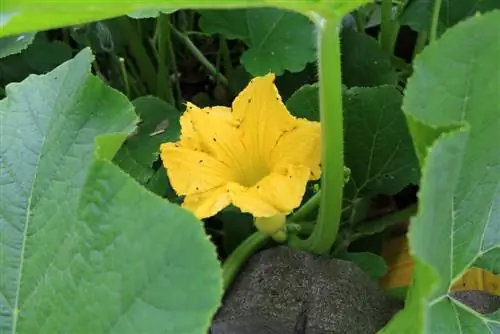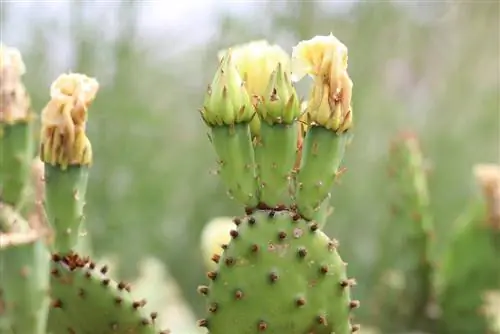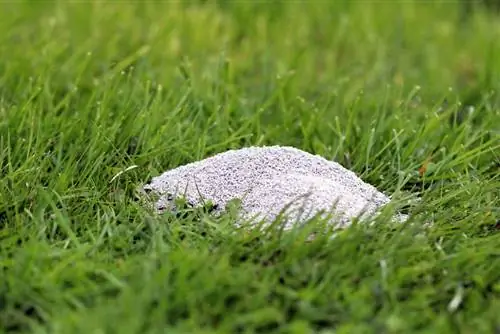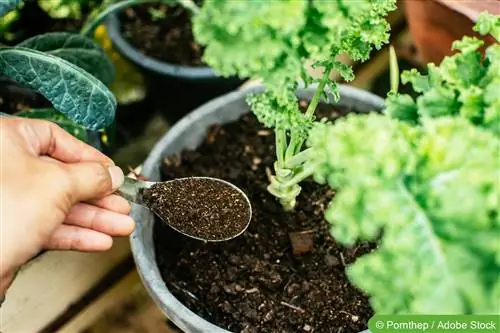- Author admin [email protected].
- Public 2023-12-17 03:39.
- Last modified 2025-01-24 12:45.
Pumpkin fertilizers, whether in organic or mineral form, all have advantages and disadvantages. Before deciding on a fertilizer, a previous soil analysis is recommended. In addition to the optimal fertilizer, compliance with crop rotation also plays an important role in ensuring that pumpkins thrive. Edible pumpkin varieties should not be planted in the immediate vicinity of ornamental pumpkins, because pumpkins are incompatible with each other, as well as with other pumpkin plants, which also include melons and cucumbers.
Basic fertilization before planting
When growing pumpkins, a large part of the fertilizer should be incorporated into the soil before planting, such as:E.g. compost, manure, cattle or horse manure or other organic or mineral fertilizers from specialist retailers. This fertilization is referred to as basic fertilization. The best time for basic fertilization is in autumn or early spring. Now the pumpkin needs a nitrogen-based pumpkin fertilizer. One square meter contains 60 g of compost, manure, horn shavings or green manure. For mineral fertilizers, 80 g per square meter. This dosage is enough for about 6 weeks. After these 6 weeks, a potassium-based fertilizer should be given because the needs of pumpkins change as they mature.
In winter, another dose of potash fertilizer is recommended. Planting on an area where green manure plants previously grew is particularly advantageous. These plants enrich the soil with humus and nitrogen, prevent nutrients from being washed out, loosen up crop rotation, combat harmful nematodes and generally contribute to soil he alth.
Tip:
You should avoid freshly limed soil because pumpkins are very sensitive to it. When buying mineral fertilizers, always pay attention to a high nitrogen content.
Top dressing of pumpkin plants
Pumpkins, as heavy feeders, need sufficient nutrients throughout the entire growth and flowering phase from May to September. At least three top dressings should be carried out throughout the entire growing season. Compost does a particularly good job. But plant manure, for example from nettles, or easily soluble mineral s alts in solid or liquid form are also suitable. For organic fertilizer you should calculate 20 g and for mineral fertilizer 40 g per square meter. Manure or mineral s alts are highly corrosive, so no fertilizer should get on the leaves or green parts of the plant. If you only want to use compost, it should be well matured and administered about every 14 days, approx.3-5 liters per square meter.
Tip:
You should be careful not to fertilize with too much nitrogen as this could cause the fruits to burst.
Optimal fertilization directly on the compost heap
A compost heap or a place immediately next to it offers optimal soil conditions for pumpkins, because there they find all the important nutrients in sufficient concentration. In addition, the tendrils and leaves of these plants conceal the compost pile in a very decorative way. However, the compost should be evenly moist, but not too moist, because too much moisture displaces oxygen from the compost. To protect it from too much moisture, you can cover it with a special compost tarpaulin, which is breathable and only allows small amounts of rainwater to pass through. Heavier rains bounce off.
Another advantage of such a tarpaulin is UV protection, so that the compost does not dry out so quickly in summer. In addition to the fact that compost is a very good pumpkin fertilizer, it also provides moisture and warmth, both of which are important requirements for growing pumpkins. A disadvantage of this type of planting is that the plants remove a large part of the nutrients from the compost, meaning that it can no longer be used as a soil improver for other areas. For this reason, it is not advisable to grow pumpkins in the same compost pile every year. It's best to plant it right next to it, so the nutrients remain in the compost and the pumpkin still benefits from it.
Tip:
When planting on the compost heap, additional mineral fertilization is not necessary.
Blue seed as pumpkin fertilizer
- Blue grain is a mineral fertilizer.
- Is particularly suitable for plants that should develop a lot of flowers or fruits, such as cucumbers or pumpkins.
- It is said to be particularly effective if used specifically.
- Phosphate and nitrate are contained in particularly high concentrations.
- Potassium and trace elements are also among the ingredients.
- Administer blue grain in small doses at least 3 weeks before sowing or planting.
- Blue grain can also be used for top dressing.
- With blue grain, over-fertilization can easily occur.
- This results in high nitrate pollution in the soil.
- If in doubt, it is better to use natural alternatives.
- Their effect is sometimes slightly less but completely sufficient and also harmless.
Tip:
Caution is advised with children and pets, as blue grain can be dangerous for them if they come into contact with it.
Advantages and disadvantages of organic fertilization

Organic fertilizers are a good alternative to mineral fertilizers. They are basically of natural origin and ensure an improvement in the humus supply in the soil, they compensate for nutrient losses and support soil life and soil he alth. Here, too, there are fertilizers with long-term effects such as compost, horn shavings, nettle manure or green manure. Organic fertilizers are not immediately available to the plant, but must first be converted or made available to the plant by microorganisms by gradually releasing the minerals. These fertilizers are less suitable if there is an acute lack of nutrients in the soil.
Advantages and disadvantages of mineral fertilizers
Mineral or inorganic fertilizers are manufactured industrially and chemically from natural minerals. They are highly soluble in water and, in contrast to organic fertilizers, work very quickly. This is particularly advantageous if the plants in question already show deficiency symptoms. These fertilizers also have a long-term effect, but there is a risk of over-fertilization. Accordingly, mineral fertilizers such as blue grain should only be administered in small quantities, but more frequently. A mixture with compost can also be useful.
Tip:
In order to determine the existing nutrient concentration in the soil or the actual requirement, a soil analysis is recommended. This allows you to avoid excessive supply but also impoverishment of the soil.
Conclusion
Which type of pumpkin fertilizer you ultimately choose is up to you. What is important is what is to be achieved with the fertilizer. With the right dosage you can achieve good to very good results with any fertilizer. However, for the sake of the environment, organic fertilizers are preferable.
What you need to know about natural pumpkin fertilizer
- Pumpkins are so-called heavy feeders. So they consume a lot of valuable nutrients from the soil.
- Therefore, correct fertilization is very important for optimal growth of the plant as well as the fruits.
- However, you also need a little sensitivity when fertilizing, because not every fertilizer is suitable.
- In principle, ornamental pumpkins are fertilized differently than vegetable pumpkins.
- Pumpkins grow and thrive excellently in compost heaps. One of these offers all the necessary nutrients at once.
- However, you should not grow on the same compost heap every year as this can lead to poorer results.
- Of course, compost is also suitable as fertilizer in the field or in the bed.
- Sometimes there is also the option of collecting green waste directly from the disposal station.
- The location of the compost also plays a role. It should be in the sun, but also protected from the wind, because pumpkins like it warm.
Tip:
If you want to use other fertilizer in addition to compost, you should make sure that it is suitable for food. If ornamental pumpkins are to be fertilized, this is not very important. When fertilizing, care should be taken to ensure that there is sufficient nitrogen supply as well as a sufficient proportion of potassium.






